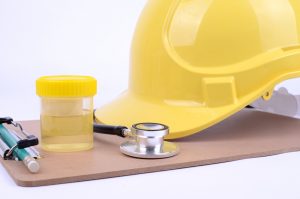Drug testing in the construction industry
 Your business has a responsibility to improve site safety by any method available. If your employees are using drink or drugs, they are at increased risk of causing an accident that injures themselves or their colleagues.
Your business has a responsibility to improve site safety by any method available. If your employees are using drink or drugs, they are at increased risk of causing an accident that injures themselves or their colleagues.
To better manage these risks, you should seriously consider implementing drug and alcohol testing for your workers.
What is workplace substance abuse testing?
In the same way that the police regularly breathalyse drivers to detect drink drivers, many employers are beginning to introduce their own tests. These tests detect the presence of alcohol or drugs in a worker’s bloodstream, indicating whether they are currently under the influence.
Using a simple urine test, workers can be checked in a matter of minutes – and at a relatively low cost. Urine testing kits are widely available, and administering the test is quick and simple – almost fool proof. Simply pee in the supplied container and wait 10 minutes for the test results to develop.
Another good choice is saliva testing. Saliva tests are readily available, and provide accurate results in as little as 10 minutes. You simply swab the inside of the employee’s mouth, place in the supplied container and wait for the results to develop.
Hair testing is even more accurate, revealing drug and alcohol use in the previous three months. The downside is that you must take a small sample of hair and send it to a lab for analysis. This will take several days and is much more expensive that urine and saliva tests.
Why should you consider workplace substance abuse testing?
Substance abuse testing is a vital tool for improving on-site safety. One study – “Evaluation of Drug Testing in the Workplace: Study of the Construction industry” – found that within two years of introducing drug testing, businesses were able to reduce on-the-job injuries by 51%.
Drug use is also more common than many employers realise. A Home Office survey found that 70% of substance misusers are currently in full-time employment, destroying the myth that drug use is the preserve of the unemployed. More importantly, the same study found that drug users were 3.6 times more likely to be involved in an accident than non-users.
Every on-site incident presents a danger to the substance misuser and their colleagues.
Testing for more than just substance abuse
Substance misuse often masks other important health factors. Depression is often closely aligned with drug use, for instance, providing a useful indicator of overall wellbeing.
Around 350,000 UK construction workers are believed to be affected by depression, that’s one-in-six of all employees in the sector. They are also much more likely to commit suicide than be involved in a workplace accident.
Because of the correlation between drug use and mental health, being able to identify substance misusers within the workplace offers a helpful way to spot at-risk individuals, and to offer additional help and support to them.
How do you go about implementing workplace substance abuse testing?
There are four key steps to rolling out your own substance abuse testing regime.
1. Decide how and why you will test your employees
Before launching into workplace substance abuse testing, you need to define a sensible policy that outlines how tests take place. You can ask employees to take tests before making an offer of employment, or after an on-site incident. For employees using heavy machinery or involved in particularly high-risk activities, you could also consider introducing random testing, carrying out spot checks to ensure they remain clean over the long term.
2. Update the employee handbook
Once you have the how and why of your testing regime decided, the next step is to update your employee handbook so that everyone knows what to expect. You should also have the policy to ensure that it is fully compliant with UK employment law – otherwise, you may run into problems later.
3. Answer your employees’ questions
With the policy published, you should arrange a question and answer session with employees. This gives you an opportunity to explain why the new measures are coming into play – to help keep employees safe. At the same time, your staff can get answers to their own questions about what to expect. You should also use the opportunity to obtain signatures from employees, indicating their agreement with the new policy.
4. Prepare for push-back
You may encounter some opposition – this is not a sign that those complaining are substance abusers. Some may simply find requests for urine samples to be embarrassing or demeaning – which is why you must be open and honest about the procedures, and how they will keep workers safe.
Get it right, get help
Substance abuse screening is a useful tool in the fight against accidents on construction sites. For any business serious about doing their best by employees and the general public, carrying out these tests should be a serious consideration.
To learn more about substance misuse testing and how it can be used effectively on your work sites, please get in touch.

A chartered (fellow) safety and risk management practitioner with 20+ years of experience. David provides a healthy dose of how-to articles, advice and guidance to make compliance easier for construction professionals, Architects and the built environment. Get social with David on Twitter and Linkedin.



